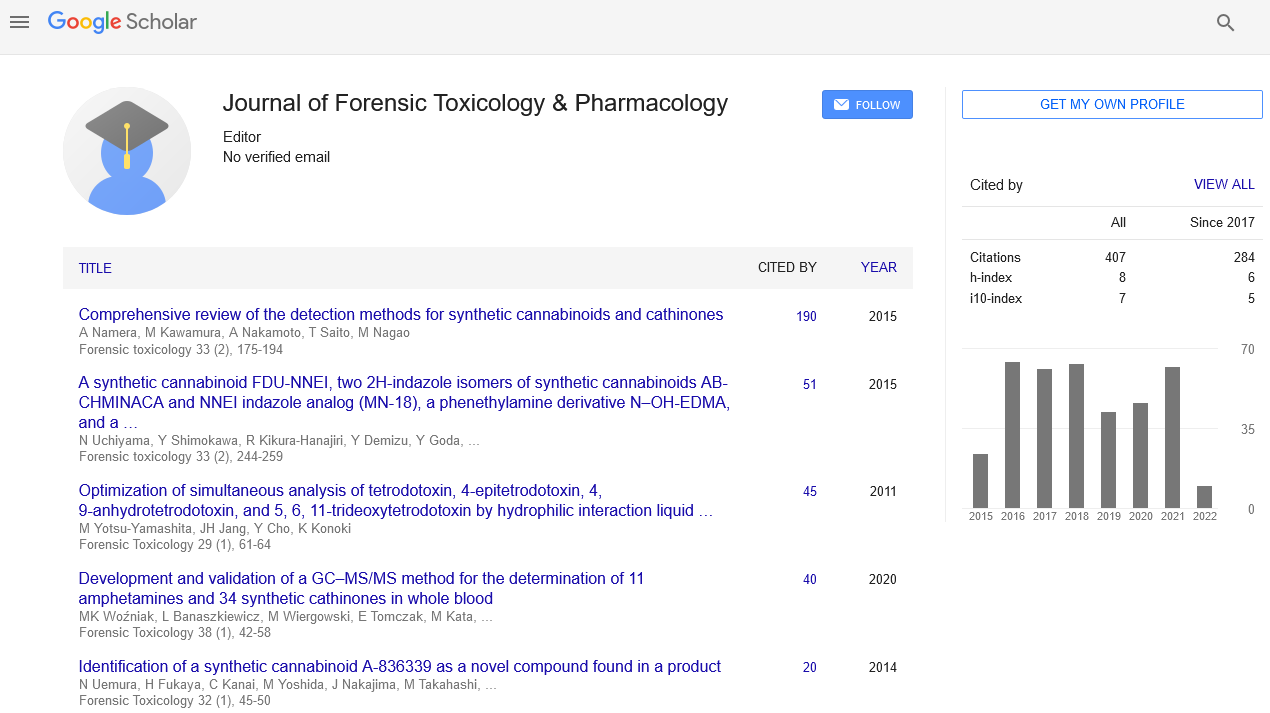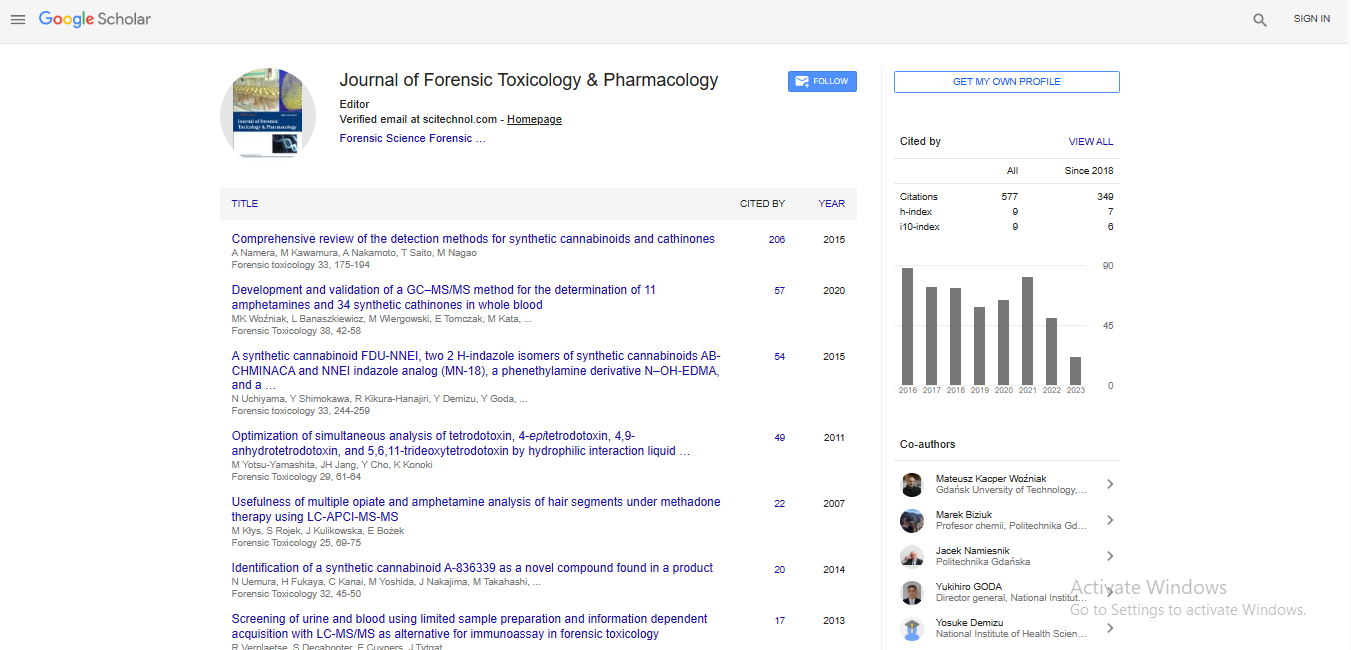Perspective, J Forensic Toxicol Pharmacol Vol: 13 Issue: 4
Analytical Approaches to Trace Contaminants in Biological Samples
Nurubeyli Noga*
1Department of Forensic Medicine, University of Copenhagen, Copenhagen, Denmark
*Corresponding Author: Nurubeyli Noga,
Department of Forensic Medicine,
University of Copenhagen, Copenhagen, Denmark
E-mail: noganurubeyli@gmail.com
Received date: 26 November, 2024, Manuscript No. JFTP-24-156269;
Editor assigned date: 28 November, 2024, PreQC No. JFTP-24-156269 (PQ);
Reviewed date: 12 December, 2024, QC No JFTP-24-156269
Revised date: 19 December, 2024, Manuscript No. JFTP-24-156269 (R);
Published date: 26 December, 2024, DOI: 10.4172/JFTP.1000204.
Citation: Noga N (2024) Analytical Approaches to Trace Contaminants in Biological Samples. J Forensic Toxicol Pharmacol 13:4.
Description
Tracing contaminants in biological samples is a fundamental of analytical toxicology, requiring precise and reliable methods to detect even minute concentrations of potentially harmful substances. The significance of this activity ranges clinical diagnostics, forensic investigations and environmental monitoring, as the presence of contaminants often correlates with adverse health outcomes or ecological disturbances.
The complexity of biological matrices, such as blood, urine and tissue samples, poses significant challenges in contaminant analysis. These matrices are inherently complex, containing a plethora of endogenous substances that can interfere with the detection of exogenous contaminants. Consequently, developing methods that achieve high sensitivity and specificity while minimizing matrix effects is a primary goal for analytical toxicologists.
Mass Spectrometry (MS) has emerged as a pivotal tool in this field, offering unparalleled sensitivity and accuracy. Techniques like Gas Chromatography-Mass Spectrometry (GC-MS) and Liquid Chromatography-Mass Spectrometry (LC-MS) allow for the separation and identification of contaminants based on their chemical and physical properties. These methods are particularly advantageous in detecting trace levels of pesticides, heavy metals, pharmaceuticals and illicit drugs. The coupling of chromatographic techniques with mass spectrometry enhances the analytical power, providing detailed molecular information that aids in the accurate identification of contaminants.
In addition to traditional chromatographic methods, advanced sample preparation techniques play a important role in ensuring reliable analysis. Methods such as Solid-Phase Extraction (SPE), Liquid- Liquid Extraction (LLE) and protein precipitation are commonly employed to isolate contaminants from biological matrices. These techniques improve the signal-to-noise ratio by removing interfering substances, enabling more accurate quantification of trace contaminants.
Recent advancements in analytical instrumentation have further refined the detection capabilities of toxicological studies. High- Resolution Mass Spectrometry (HRMS) and tandem Mass Spectrometry (MS) have revolutionized the field by providing higher accuracy, lower detection limits and faster analysis times. These technologies facilitate the identification of unknown contaminants, even in complex mixtures, by utilizing extensive spectral libraries and advanced computational algorithms.
Another significant development in analytical toxicology is the integration of bioinformatics tools. The application of machine learning and data mining techniques has enhanced the interpretation of complex datasets, enabling researchers to identify patterns and correlations that were previously elusive. These tools are particularly useful in metabolomic studies, where the comprehensive analysis of small molecules in biological samples provides insights into the metabolic pathways influenced by toxicants.
Standardization and validation of analytical methods remain critical to ensure reproducibility and reliability across laboratories. Regulatory agencies, such as the Food and Drug Administration (FDA) and the European Medicines Agency (EMA), provide guidelines for method validation, emphasizing parameters like accuracy, precision, linearity and robustness. Adhering to these guidelines ensures that analytical results are reliable and can withstand scrutiny in clinical or legal contexts.
The future of contaminant analysis in biological samples is likely to witness the integration of miniaturized and portable analytical devices. These innovations aim to bring laboratory-grade analysis to field settings, enhancing the rapid detection of contaminants during emergencies or on-site investigations. Furthermore, the adoption of green chemistry principles in analytical methodologies is gaining momentum, focusing on reducing hazardous reagents and waste while maintaining analytical performance.
The analytical approaches to trace contaminants in biological samples are a testament to the remarkable progress in toxicology and analytical chemistry. By enhancing advanced instrumentation, sophisticated sample preparation techniques and bioinformatics tools, researchers can achieve unprecedented levels of accuracy and sensitivity in detecting contaminants. These advancements not only bolster the reliability of toxicological assessments but also contribute to safeguarding public health and environmental integrity.
 Spanish
Spanish  Chinese
Chinese  Russian
Russian  German
German  French
French  Japanese
Japanese  Portuguese
Portuguese  Hindi
Hindi 
